This post may contain affiliate links. Please read our disclosure policy.
A no-fuss way to spice up any meal, my homemade tzatziki sauce is an authentic taste of Greece, perfect for dipping and drizzling in as many dishes as you can think of.
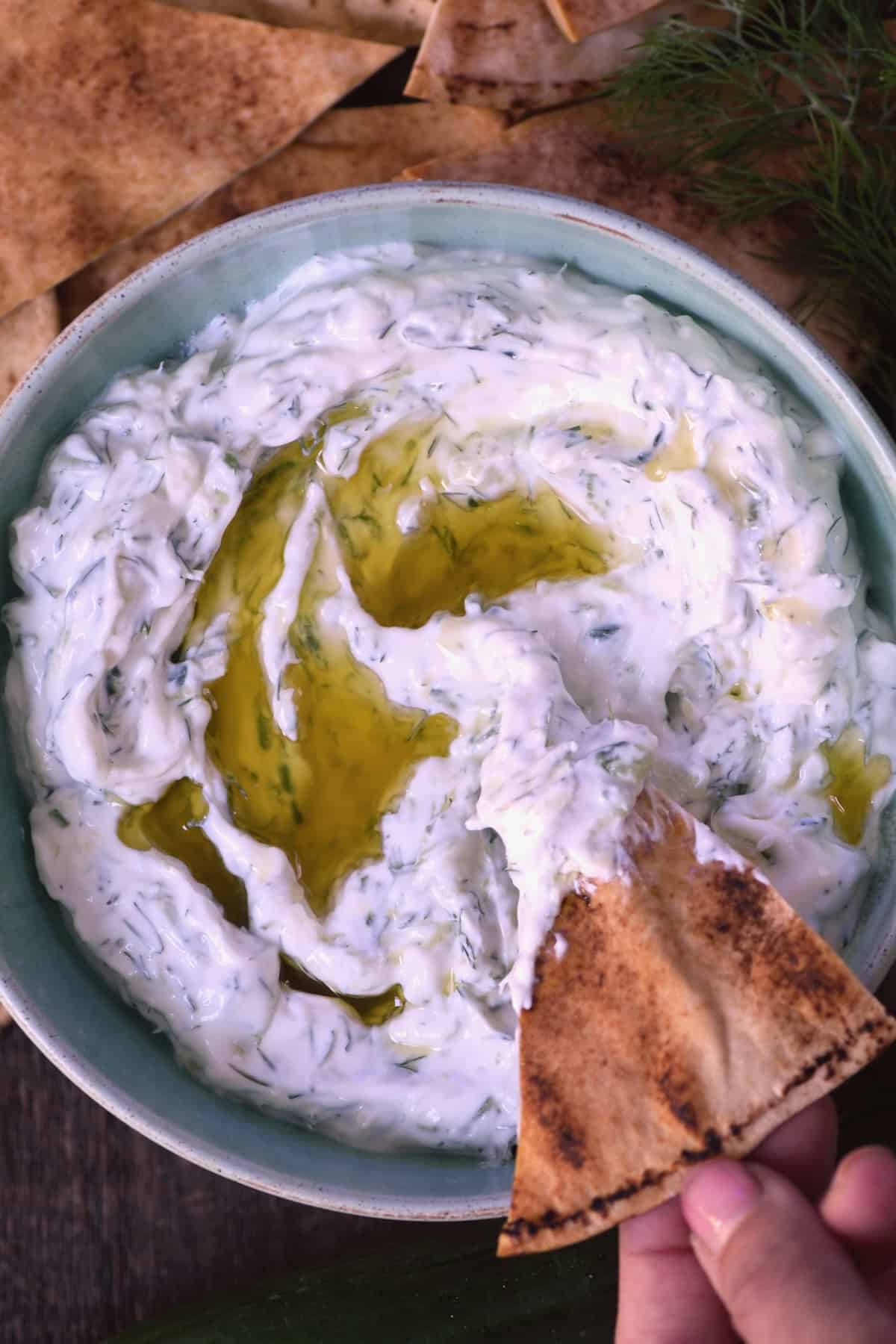
I’d like to think that there’s nothing in this world that doesn’t go with tzatziki. My tzatziki recipe – based on the traditional Greek yogurt sauce – doesn’t stray too far from the original. But it remains low-carb, gluten-free, and oh so delicious.
You can use it as a gyro sauce recipe or as a dip for vegetable sticks or, my personal favorite, zucchini fries. The possibilities for this tzatziki sauce recipe are endless.
Want to save this recipe?
What is Tzatziki sauce?
Tzatziki dip is a creamy Greek sauce popularised both in the Mediterranean regions of Europe and the Middle East. With a cool, yogurt cucumber sauce base, the traditional tzatziki sauce recipe is generally seasoned with dill, salt and pepper, olive oil, and lemon juice. Though there are plenty of variations on the classic. In Greece especially, it’s most commonly used as a greek sauce for gyro, as an accompaniment to souvlaki, or as part of a mezze.
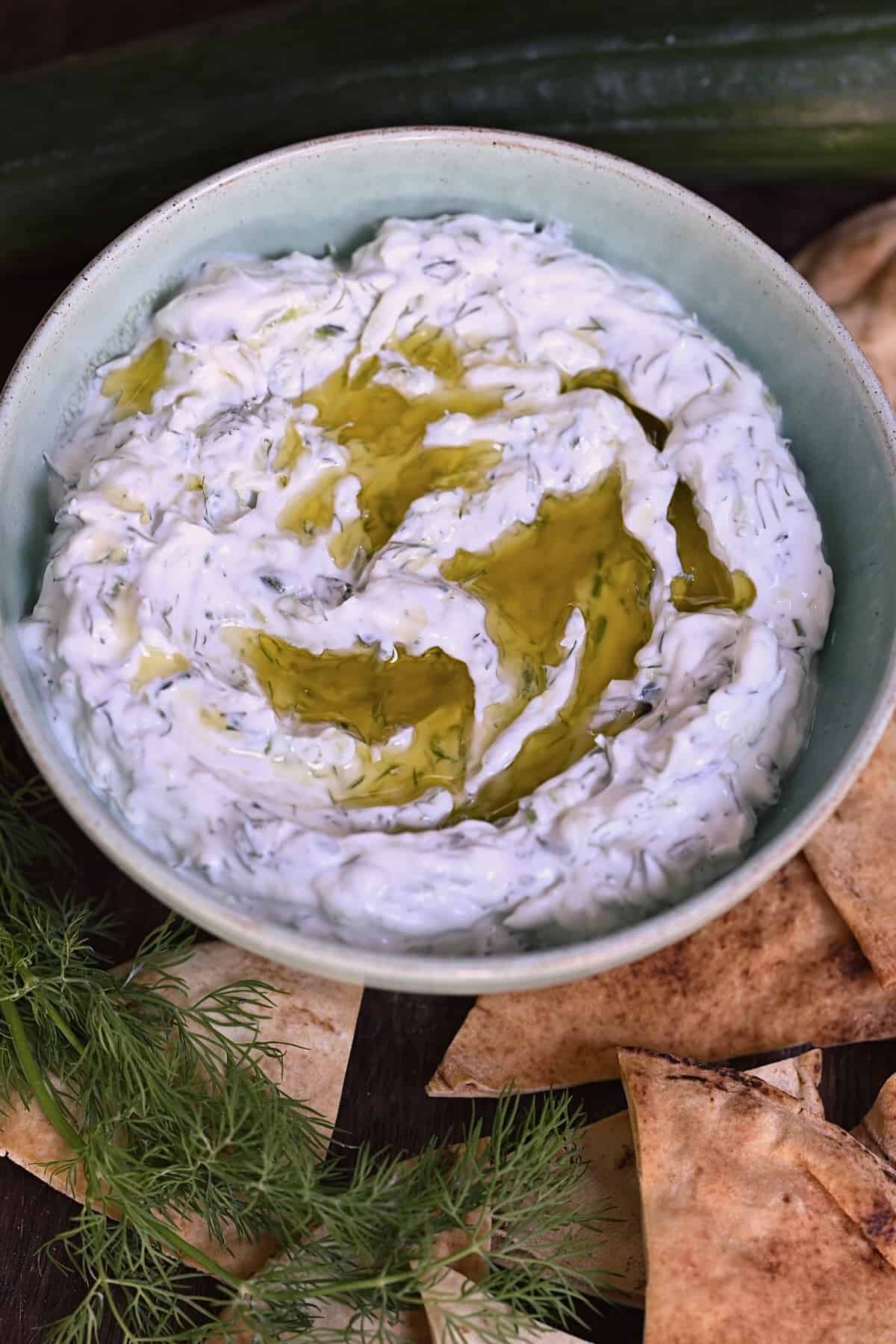
What is the difference between Tzatziki and yogurt sauce
Traditionally, the core difference is the extra ingredients of tzatziki. Both sauces have the same yogurt and cucumber base. But a Greek yogurt sauce has fewer additional ingredients. It is unlikely to include lemon juice, dill, garlic, olive oil, etc.
On the other hand, this homemade tzatziki sauce is bursting with extra flavors that you’ll only find in Greek tzatziki recipes.
Is Tzatziki sauce healthy
The Mediterranean diet is noted for how healthy it is. And tzatziki – being a Mediterranean yogurt sauce – is surprisingly good for you.
Its base of Greek yogurt is naturally high in protein. And the additional fresh ingredients are generally high in essential vitamins and minerals. Tzatziki dip is naturally low-calorie, low in cholesterol, and high in Vitamin A and calcium.
Tzatziki sauce ingredients
- Cucumber: It’s best to use seedless or small-seed cucumber varieties like English cucumbers or Persian cucumbers. These won’t get mushy too quickly. If all you have is a seedy cucumber, then de-seed it first.
- Plain Greek yogurt: Full-fat Greek yogurt is the best option for this recipe (though sheep’s milk yogurt is the most authentic). However, you could also use regular plain yogurt and strain it for a couple of hours. See the FAQs below for how to make strained yogurt.
- Dill: Lots of fresh dill is the key to packing in tons of flavor. Only use dried dill if you have to.
- Garlic: Crushed or minced. An authentic tzatziki sauce won’t go easy on the garlic – it should be strong. Feel free to adjust the amount to your liking, though.
- White vinegar: For authentic flavor, use white vinegar. Alternatively, you could use apple cider vinegar or even lemon juice. However, the flavor will vary.
- Olive oil: This will add a smooth mouthfeel and is perfect for garnishing.
- Salt: To enhance the flavor.
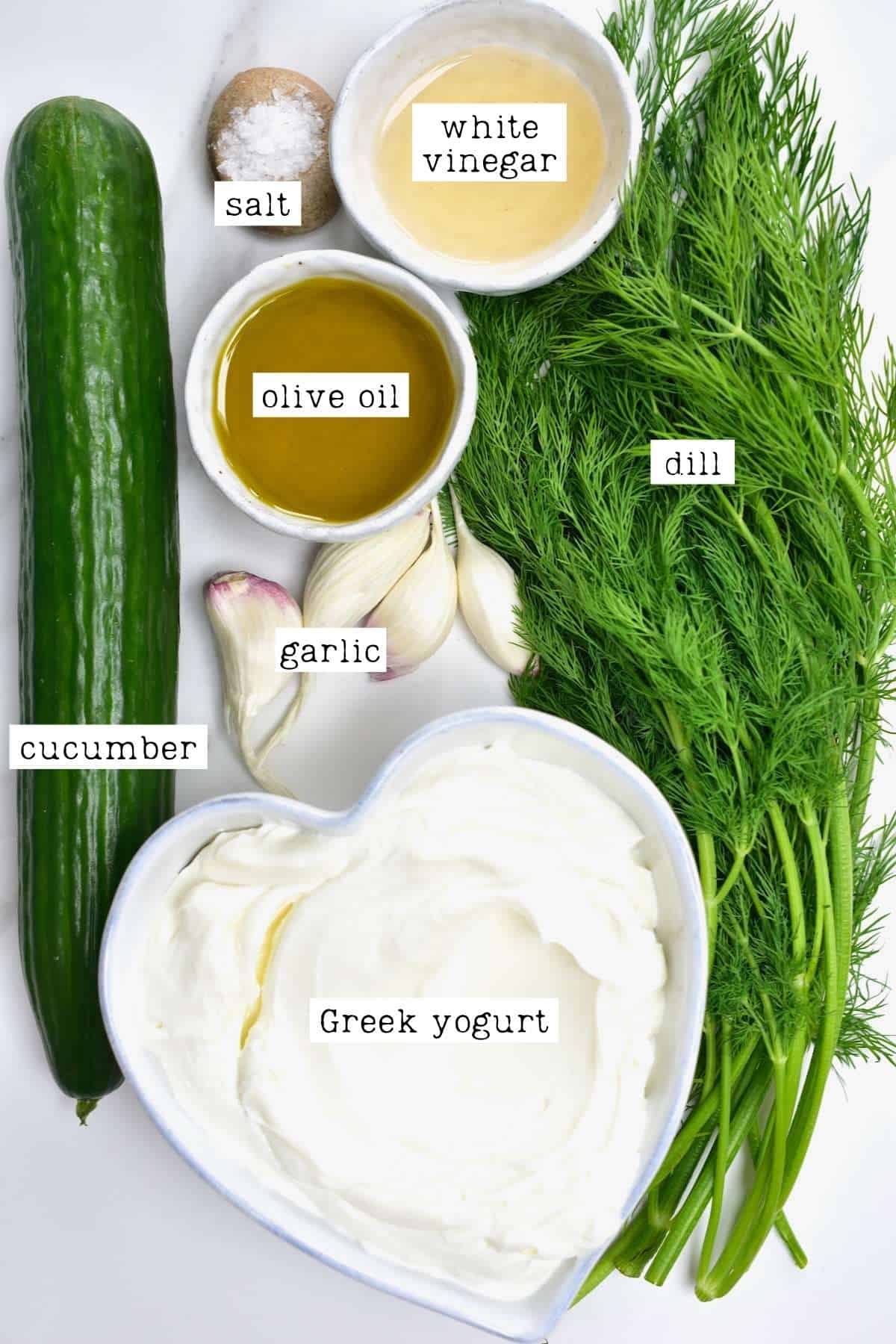
How to make Tzatziki sauce
There are just a few simple steps for the best tzatziki recipe.
Step 1: Prepare the cucumber
Grate the cucumber with a box grater and optionally sprinkle it with salt (this will help extract the excess liquid). Set aside for 10 minutes.
I say that the salt is optional because the cucumber juice that you squeeze from the cucumber is delightful as a drink. But not so much if it’s salty!
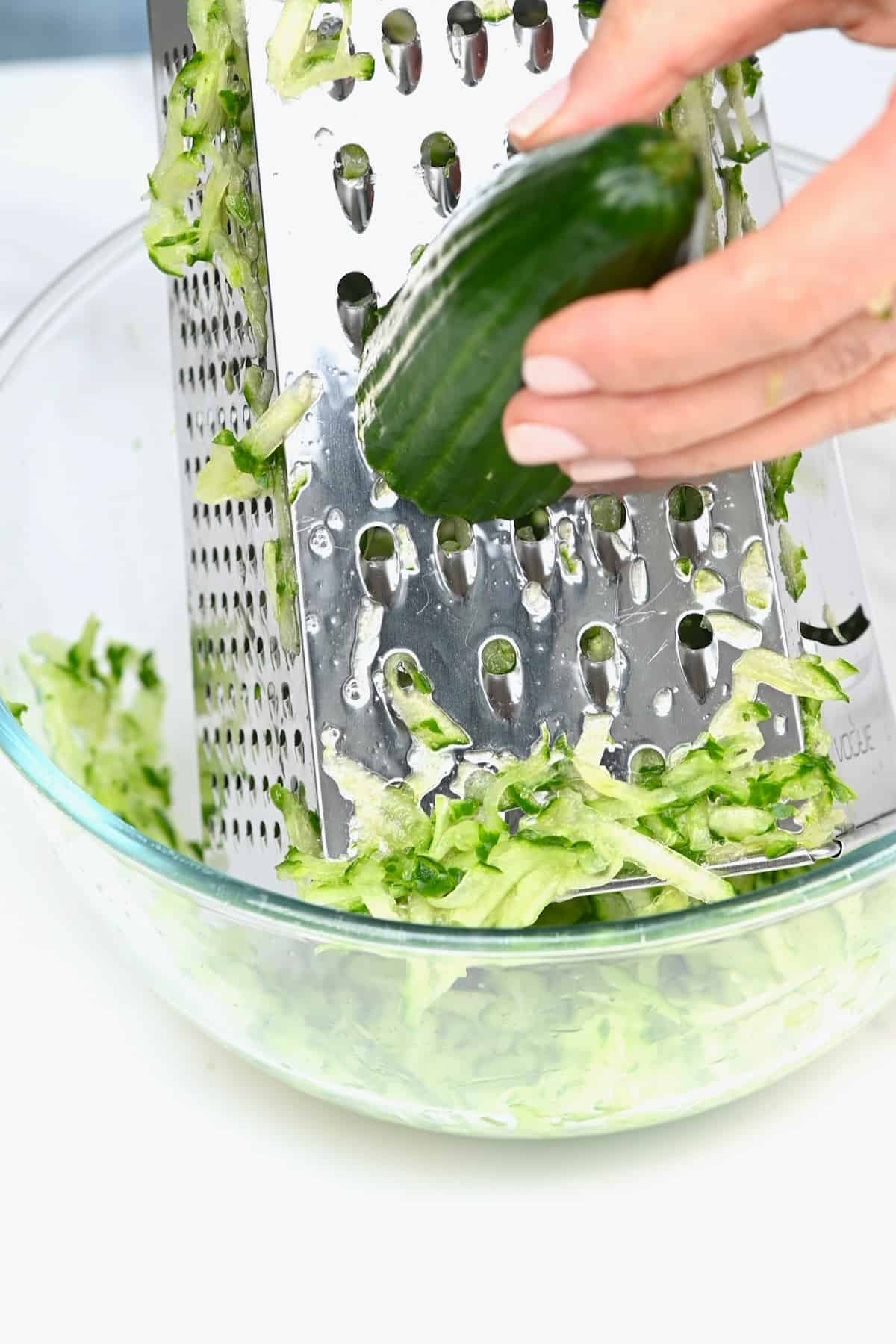
Place the rested cucumber into nut milk back or several layers of cheesecloth. Squeeze out as much excess water as possible.
Alternatively, you can salt the cucumbers and leave them in a colander to naturally drain with the help of gravity. This will provide the best texture for the cucumber. However, this will take a far longer resting time (like overnight!), so I usually avoid it.
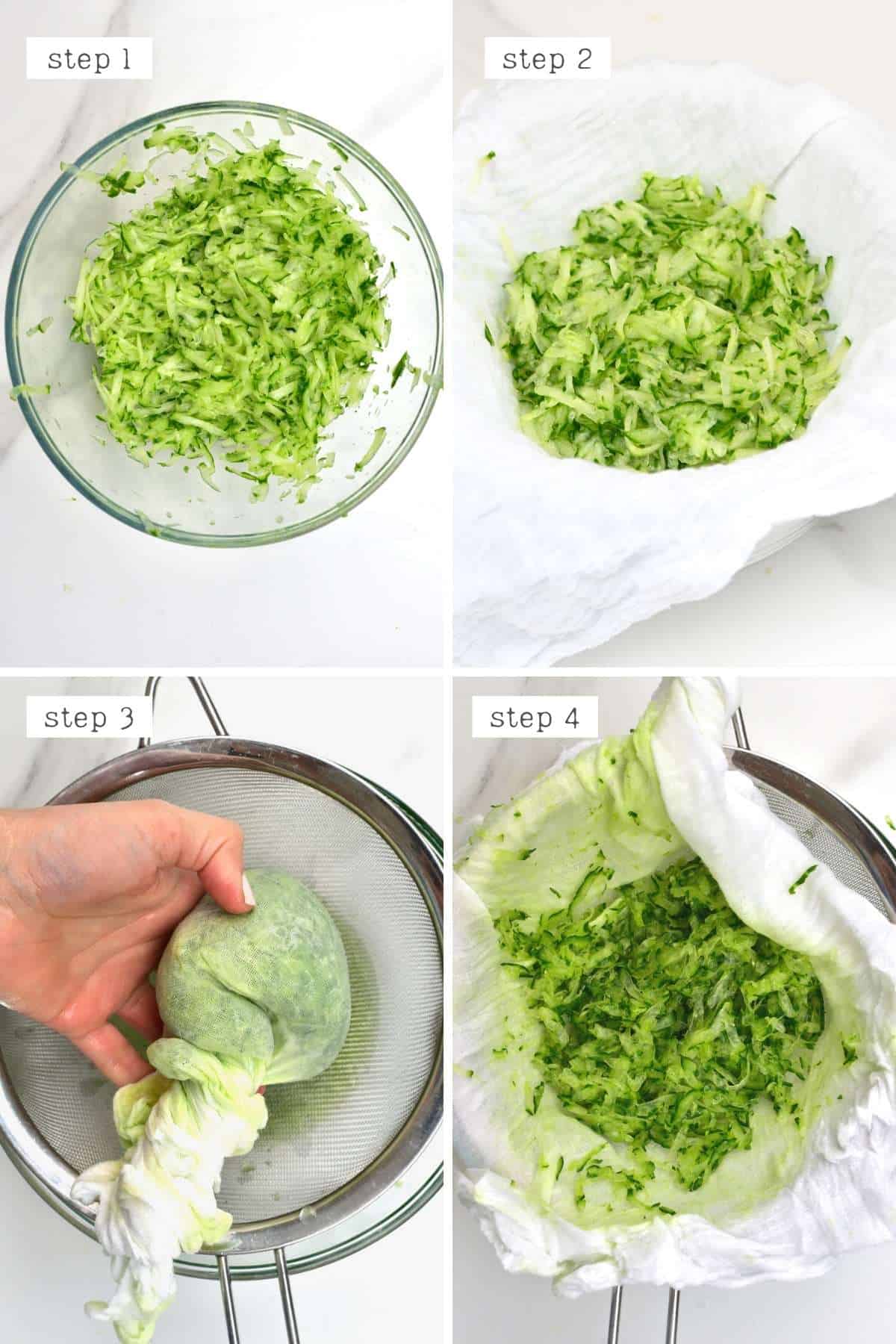
Step 2: Prepare the remaining ingredients
Finely chop the dill and grate or mince the garlic. If you need help peeling garlic, I’ve tried and tested several methods to peel garlic.
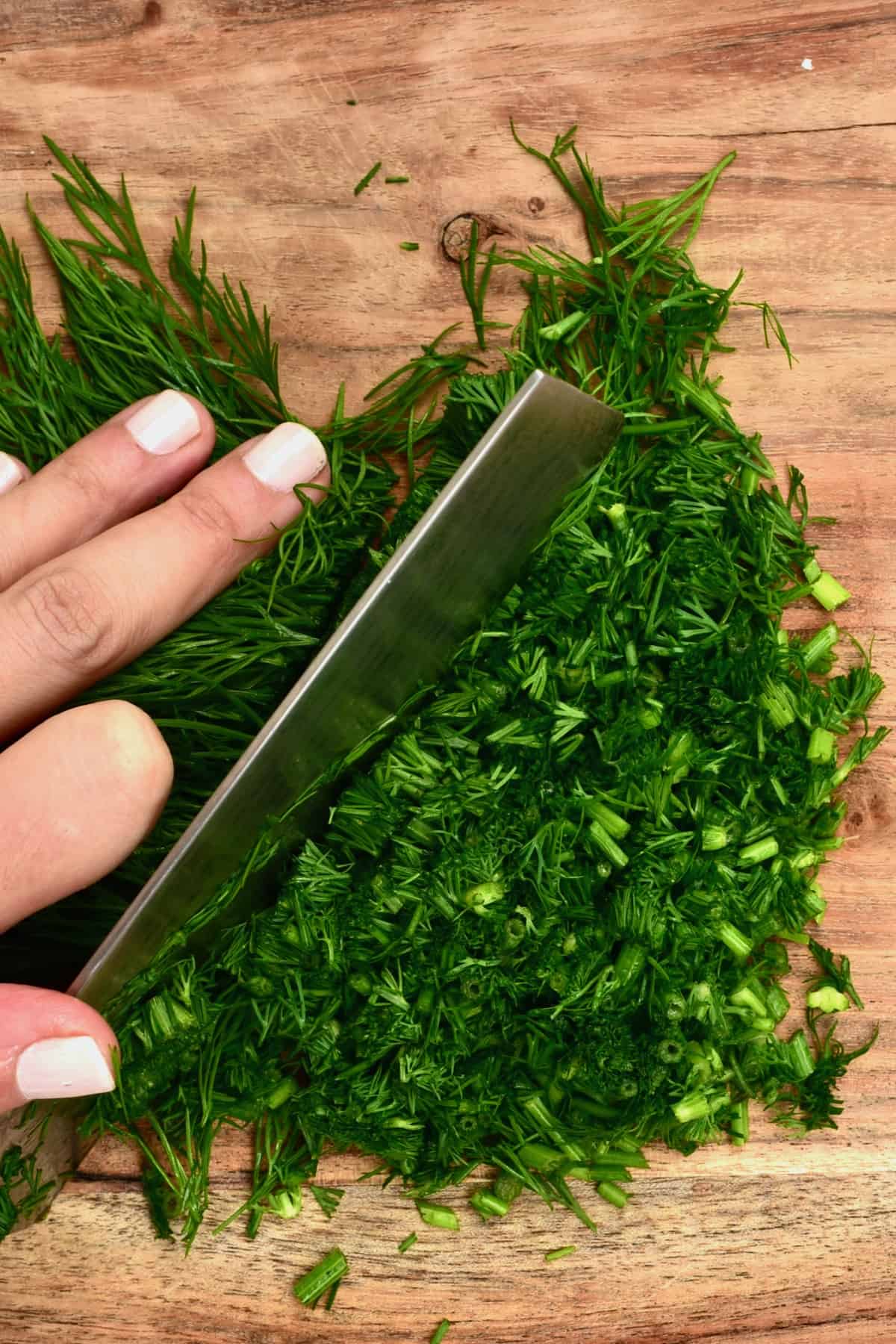
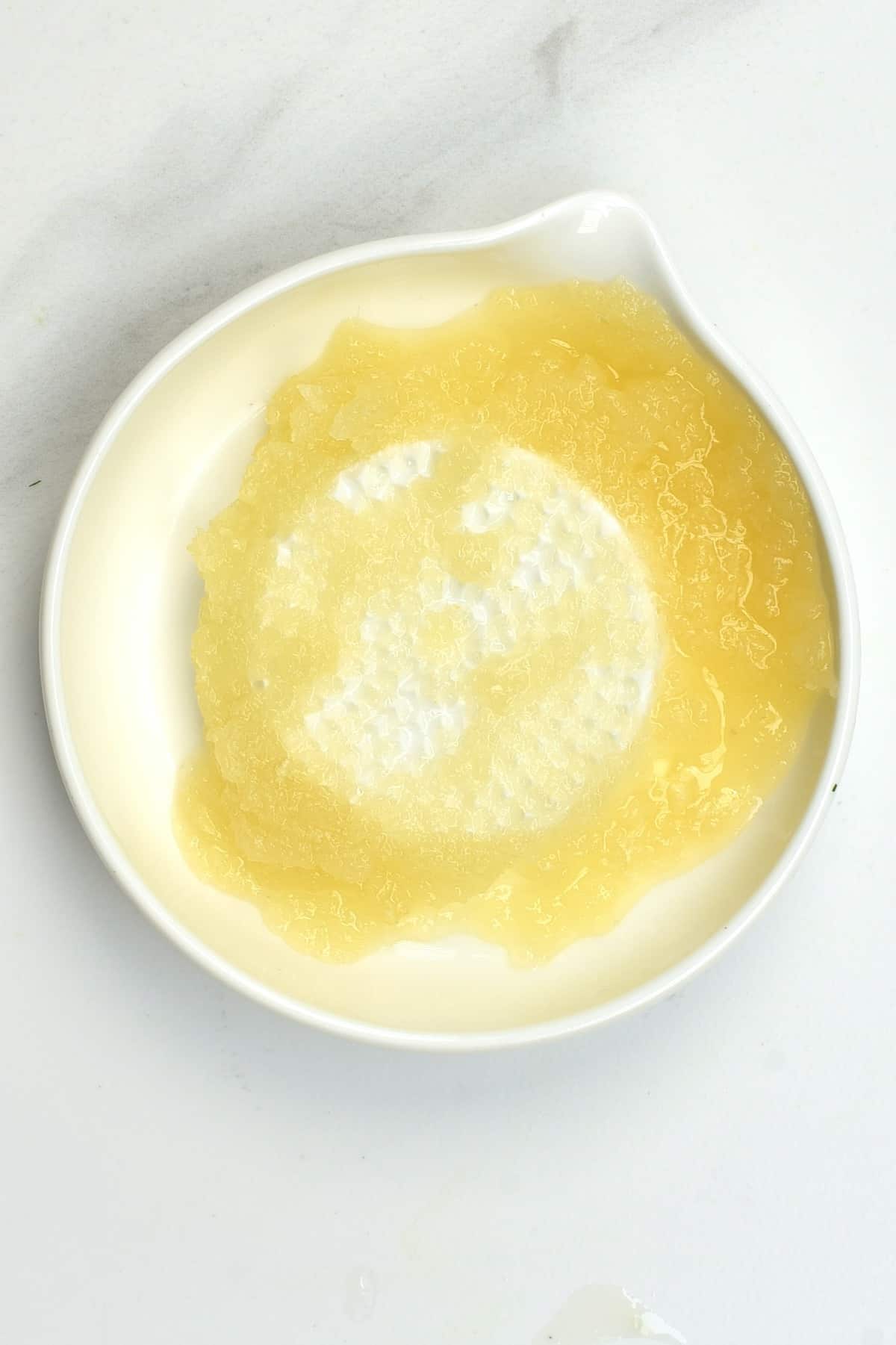
Step 3: Mix the Tzatziki Sauce
Combine all the ingredients in a large bowl and mix well.
For the best flavor, allow the Greek sauce to marinate in the fridge for at least 2 hours but even better overnight. This will give the flavors a chance to meld together properly and tastes better than directly after making it.
Before serving, give it one last taste and adjust any of the ingredients if needed (more salt, acidity, etc). Then drizzle with a bit of additional olive oil, and enjoy!
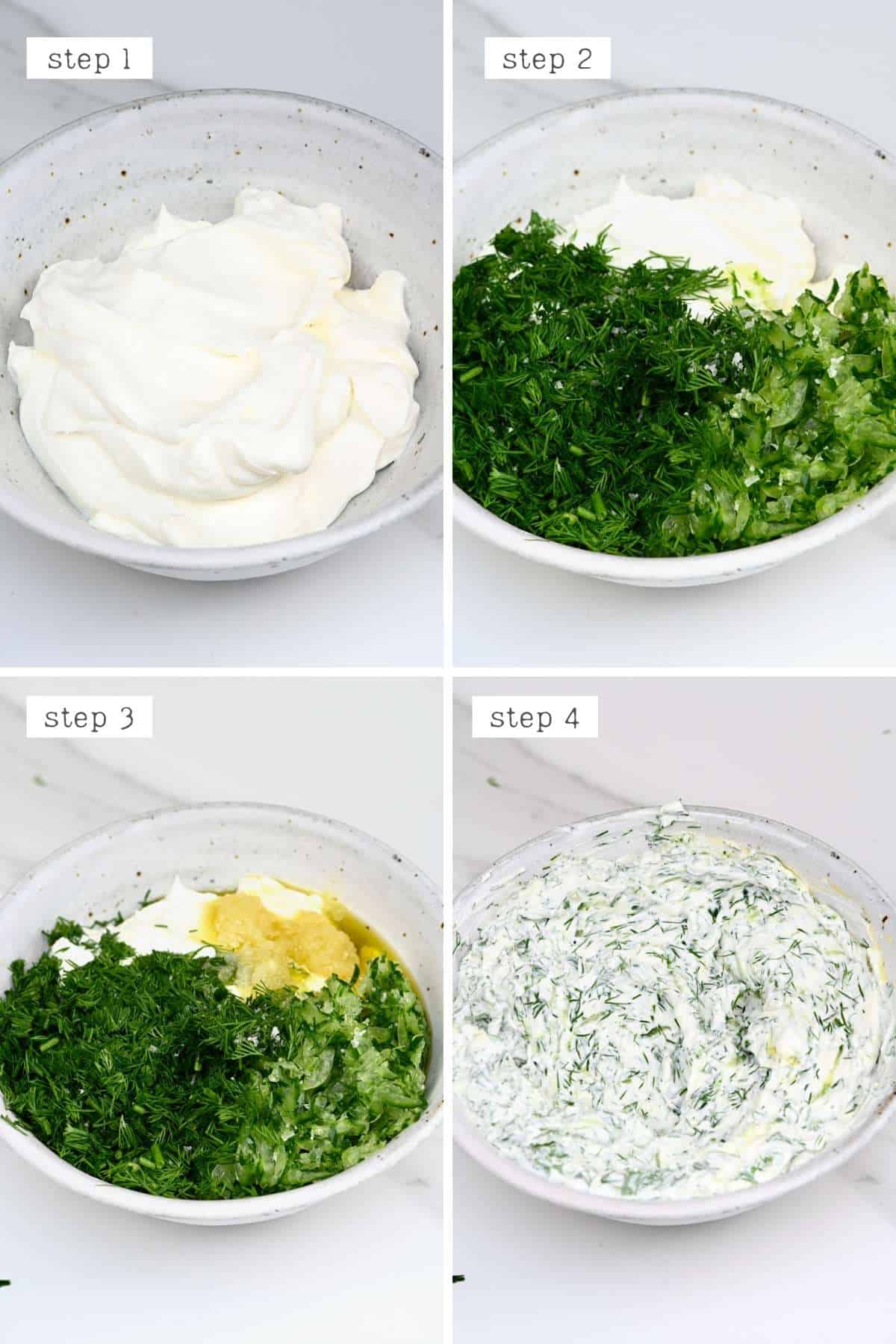
Can you freeze Tzatziki sauce
I do not recommend freezing the tziki sauce. But if you need to, pour it into a freezer-safe, air-tight container. It will keep in your freezer for 3 months. Keep in mind the texture will change upon thawing.
What to eat with Tzatziki sauce
Spread it liberally on souvlaki/gyros wraps (it’s the ultimate gyro sauce!) and with calamari. Plus, there are still tons of other ways to enjoy this authentic Greek tzatziki sauce:
- As an appetizer/dip with crudites or Greek pita for dipping.
- For dipping with french fries and potato wedges – even zucchini or eggplant fries.
- Spread in sandwiches, burgers (like these juicy turkey burgers), or wraps. Or enjoy alongside hot arayes.
- Served as part of a mezze platter alongside dishes like dolma, greek salad, etc.
- As part of a grain bowl alongside your grain of choice, fresh veggies, olives, etc. You can also use it as tzatziki dressing.
- Serve as a side to Stuffed Vegetables (Gemista/Yemista) and other Greek food.
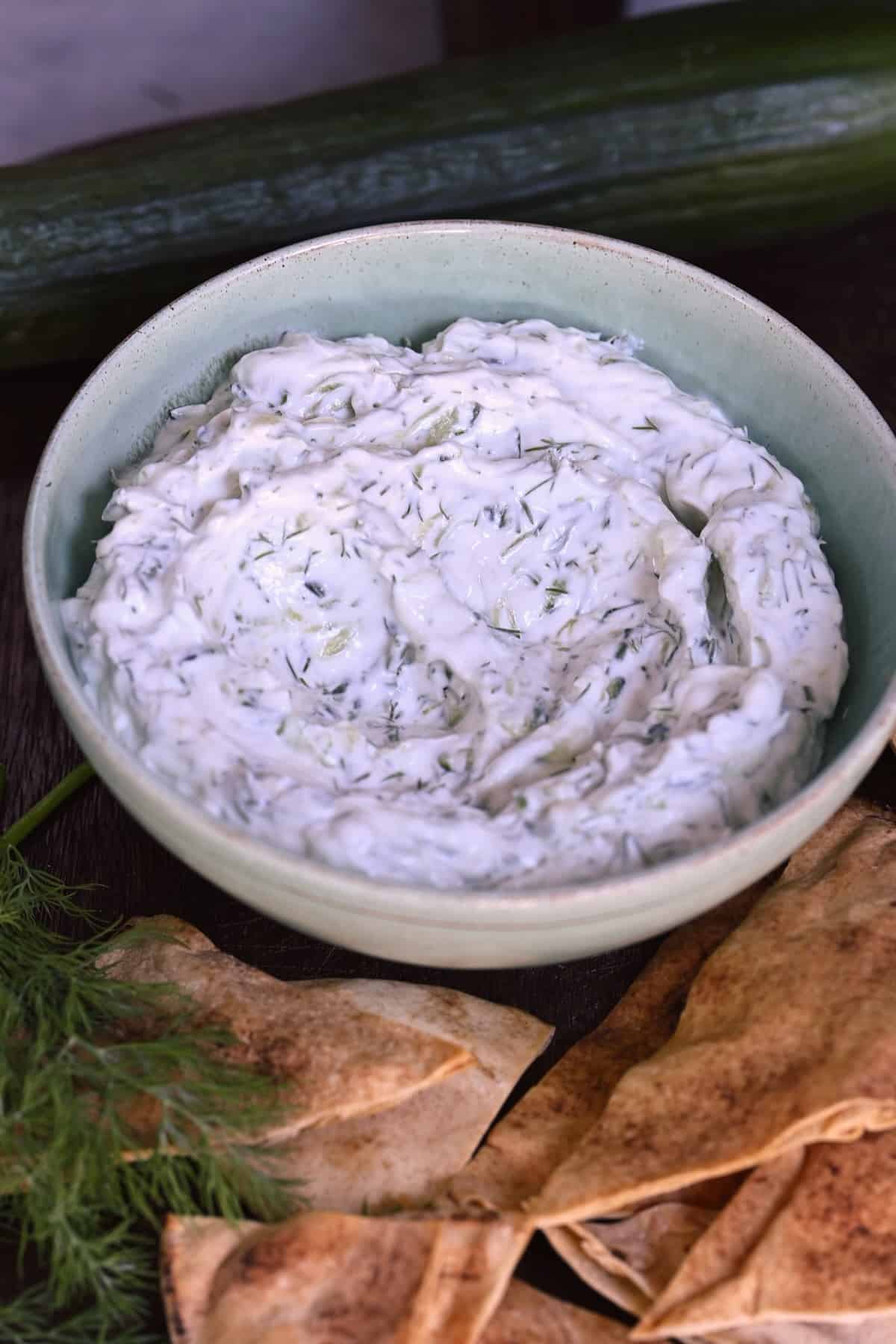
FAQs
By draining the cucumber, you get rid of some of the excess liquid and extend the dish’s shelf life. The cucumber won’t release its juices quickly and you won’t have watery, mushy sauce.
Similarly to letting the cucumber drain naturally, that’s how plain yogurt drains. Layer some cheesecloth in a colander or transfer the yogurt into a nut milk bag. Allow it to hang over a bowl and naturally drain the excess whey.
This will take at least a few hours, if not overnight- so plan for this time.
While some recipes do call for peeled cucumber, I prefer it with the peel on. Not only does it add more nutrients and fiber, but it also helps keep the cucumber yogurt sauce a little crunchier too!
You’ll only need to peel the cucumber if you’re using a variety with thick, bitter skin.
Other dip & sauce recipes
If you try this easy tzatziki recipe, let me know how it goes in the comments below. I’d appreciate a recipe card rating and would love to see your recipe recreations – tag me on Instagram @Alphafoodie!

Tzatziki Sauce Recipe (Authentic & Easy)
Ingredients
- 24 oz Greek yogurt or plain yogurt, 3 cups drained
- 10 oz English cucumber or other small-seed/seedless varieties, 1 large
- 0.88 oz dill 1 cup chopped
- 0.7 oz garlic 2 large or 4 small cloves
- 2 Tbsp olive oil
- 1 Tbsp white vinegar or apple cider vinegar or lemon juice (not authentic)
- 1 tsp salt
Optional add-ins
- dried mint
Instructions
Step 1: Prepare the cucumber
- Grate the cucumber and optionally sprinkle with salt (this will help extract the excess liquid). Set aside for 10 minutes.I say that the salt is optional because the cucumber juice that you squeeze from the cucumber is delightful as a drink – but maybe not so much if it's salty!
- Place the rested cucumber into a nut milk back or several layers of cheesecloth and squeeze out as much excess water as possible.Alternatively, you can salt the cucumbers and leave them in a colander to naturally drain with the help of gravity (this will provide the best texture of the cucumber). However, this will take a far longer resting time (like overnight!), so I usually avoid it.
Step 2: Prepare the remaining ingredients
- Finely chop the dill and grate or mince the garlic. If you need help peeling garlic, I've tried and tested several methods previously.
Step 3: Mix the tzatziki sauce
- Combine all the ingredients in a large bowl and mix well.
- For the best flavor, allow the Greek sauce to marinate in the fridge for at least 2 hours but even better overnight. This will give the flavors a chance to properly meld together and tastes better than directly after making it.
- Before serving, give it one last taste and adjust any of the ingredients if needed (more salt, acidity, etc. Then drizzle with a bit of additional olive oil, and enjoy!
How to Store
- If you've carefully drained the cucumber, then leftover tzatziki sauce will last, covered, in the refrigerator for between 3-4 days.
Notes
- Allow the tzatziki sauce to marinate: This is one of my ultimate top tips for delicious homemade tzatziki as it allows all the flavors to meld. The raw garlic will also mellow the longer it sits in yogurt too.
- To make ahead: I recommend mixing all the ingredients except the cucumber and dill together and allowing it to marinate overnight. Meanwhile, if preparing in advance, you could also leave the cucumber to naturally drain in a colander overnight too! That way, when it comes to combining all the ingredients, it’s ready to serve immediately!
- Using a food processor: You can also use a food processor to grate the cucumber and save time – either with a grating disk or just pulsing it into a fine “mush”. Obviously, the latter will affect the texture of the tzatziki sauce, too. However, DON’T use a food processor to mix the yogurt as it can cause it to “break down” slightly and become more watery.
- Herbs: Dried mint (better than fresh, which will change color), dried oregano, chili flakes, cumin, fresh parsley (to garnish), black pepper, etc. For spice, you could add a dash of cayenne.
- Veggies: Shredded carrot, onion, or even lemon zest (not technically veg, but it makes the most sense in this category). You can also add legumes like white beans or cooked chickpeas to bulk up the sauce.
- Optional toppings: Pomegranate seeds, fresh or roasted tomatoes, crushed walnuts (also usable within the tzatziki sauce), sesame seeds, olives, etc.
- Vegan tzatziki sauce: for dairy-free tzatziki, all you need to do is substitute the dairy yogurt for a dairy-free alternative – Greek style would be best. Otherwise, coconut yogurt would work – you’ll likely need a little extra lemon/vinegar to add “tang” or use a dairy-free sour cream and yogurt combination.
Nutrition
Nutrition information is automatically calculated, so should only be used as an approximation.



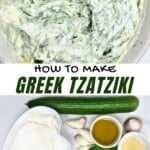



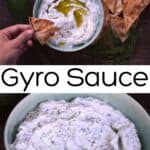











This was spot on! My husband likes it a bit smoother, so I used my immersion blender to reach the consistency he liked.
Thank you for your comment, Amy. Glad you liked it!
This recipe is AMAZING!!!! Ifollowed the make ahead tips. This was served with a Roasted leg of lamb. My Word!
Thank you for your comment, Genene. So happy you’ve enjoyed this recipe 🙂
Can you use fat free greek yoghurt or will it be too watery??
Hi Becky,
Yes, you can but it may not be as creamy as it would be with full-fat Greek yogurt.
I have to be honest, I’ve never tried tzatziki in Greece but I loveeeeed this!!!❤️ Made this tonight and I’m probably gonna dream about this tonight
Thank you for your comment, Roberta. Glad you enjoyed this recipe. 🙂